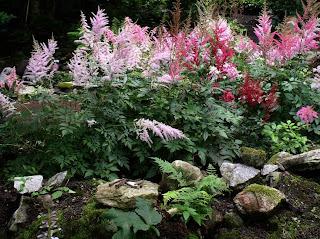
Friday, April 22, 2011
A bright morning here on the mountain. 30° in the sun but 24.9° on the shady side of the house. A beautiful day is on the way so we have to work hard and quick as rain returns by late afternoon and continues all day tomorrow.The woodpeckers are the noisiest they have been so far and and as I walked Karl out the door I noticed fresh-from-last-night moose tracks exiting the woods and leading up the little valley to our neighbors. Deer and moose are very mobile now and they are visible as they search for fresh food.
Gail and I are heading to the nursery in an hour to begin preparing for planting. After two years of better understanding the weather at the nursery, Gail is exchanging the miniature and small hostas and the astilbes for places that better accommodate their sunshine needs. The shade cloth we cover the houses with is 80% which some question or criticize but as the warm, direct suns of July and August come straight down, it's important to have good cover. In their new locations the astilbes will receive a little more sun and the hostas a little less. They should all smile nicely.
The little sundial in the yard, pictured above, reflects the time of about 7 AM and the crystals of snow that fell last night. I guess it is a weather dial too. It does not tell how much work gardeners expend in the spring to get their gardens ready but it reminds Vermonters that spring takes a while to work its way through and then summer leaps forward, beautiful but too short. Get out and enjoy at least part of today.
Writing from the mountain above Peacham Pond where juncos are abundant under the unfilled bird feeders. Two doves search for the last pieces of cracked corn and a tom turkey calls loudly from the field asking his girlfriends to join him for breakfast.
George Africa
The Vermont Gardener
Find us on Facebook at George Africa or at Vermont Flower Farm and Gardens
On Twitter as vtflowerfarm
Good gardeners always remember that we are here to help you GROW your GREEN THUMB!


















